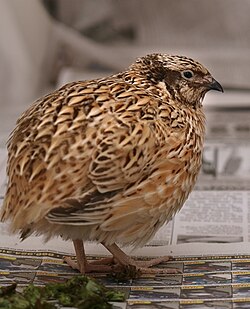Japanese quail
| Japanese quail | |
|---|---|
 |
|
| Golden speckled is just one of the many names for this color type of Coturnix japonica | |
| Scientific classification | |
| Kingdom: | Animalia |
| Phylum: | Chordata |
| Class: | Aves |
| Order: | Galliformes |
| Family: | Phasianidae |
| Subfamily: | Perdicinae |
| Genus: | Coturnix |
| Species: | C. japonica |
| Binomial name | |
|
Coturnix japonica Temminck & Schlegel, 1849 |
|
The Japanese quail, Coturnix japonica, is a species of Old World quail found in East Asia. First considered a subspecies of the common quail, it was distinguished as its own species in 1983. The Japanese quail has played an active role in the lives of humanity since the 12th century, and continues to play major roles in industry and scientific research. Where it is found, the species is abundant across most of its range. Currently there are a few true breeding mutations of the Japanese quail. The breeds from the United States are: Texas A&M, English white, golden range, red range, Italian, Manchurian, Tibetan, rosetta, scarlett, roux dilute and golden tuxedo.
Populations of the Japanese quail are known to mainly inhabit East Asia and Russia. This includes India, Korea, Japan, and China. Though several resident populations of this quail have been shown to winter in Japan, most migrate south to areas such as Vietnam, Cambodia, Laos, and southern China. This quail has also been found to reside in many parts of Africa, including Tanzania, Malawi, Kenya, Namibia, Madagascar, and the area of the Nile River Valley extending from Kenya to Egypt.
Breeding sites of the Japanese quail are largely localized to East and Central Asia, in such areas as Manchuria, southeastern Siberia, northern Japan, and the Korean Peninsula. However, it has also been observed to breed in some regions of Europe, as well as Turkey.
The Japanese quail is primarily a ground-living species that tends to stay within areas of dense vegetation in order to take cover and evade predation. Thus, its natural habitats include grassy fields, bushes along the banks of rivers, and agricultural fields that have been planted with crops such as oats, rice, and barley. It has also been reported to prefer open habitats such as steppes, meadows, and mountain slopes near a water source.
...
Wikipedia

